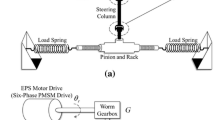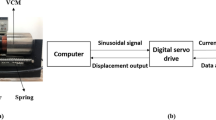Abstract
To cope with the nonlinear electro-magneto-mechanical characteristics, this paper proposes a perturbation wavelet neural sliding mode position control (PWSPC) system for a voice coil motor (VCM) driver. A perturbed wavelet neural network (PWNN) approximator is used to online approximate the unknown nonlinear term in the VCM system dynamics. The PWNN approximator uses perturbed wavelet functions to handle the rules uncertainties like interval type-2 fuzzy sets. The structure learning ability enables the PWNN approximator to evolve its structure online. Further, the parameter learning laws and stability analysis are derived in the sense of Lyapunov function; thus, the parameter convergence and system stability can be guaranteed. Finally, the experimental results verify that the proposed PWSPC system can achieve favorable control performance such as good disturbance rejection and good tracking accuracy.












Similar content being viewed by others
Explore related subjects
Discover the latest articles, news and stories from top researchers in related subjects.References
Chen YD, Fuh CC, Tung PC (2005) Application of voice coil motors in active dynamic vibration absorbers. IEEE Trans Magn 41(3):1149–1154
Liu CS, Ko SS, Lin PD (2011) Experimental characterization of high-performance miniature auto-focusing VCM actuator. IEEE Trans Magn 47(4):738–745
Shan G, Li Y, Zhang Y, Wang Z, Qian J (2016) Experimental characterization, modeling and compensation of rate-independent hysteresis of voice coil motors. Sens Actuators A Phys 251(1):10–19
Yu HC, Chen TC, Liu CS (2014) Adaptive fuzzy logic proportional–integral–derivative control for a miniature autofocus voice coil motor actuator with retaining force. IEEE Trans Magn 50(11):8203204
Wu S, Jiao Z, Yan L, Zhang R, Yu J, Chen CY (2014) Development of a direct-drive servo valve with high-frequency voice coil motor and advanced digital controller. IEEE/ASME Trans Mechatron 19(3):932–942
Pan JF, Or SW, Zou Y, Cheung NC (2015) Sliding-mode position control of medium-stroke voice coil motor based on system identification observer. IET Electr Power Appl 9(9):620–627
Li THS, Chen CC, Su YT (2012) Optical image stabilizing system using fuzzy sliding-mode controller for digital cameras. IEEE Trans Consum Electron 58(2):237–245
Lin CM, Li HY (2012) A novel adaptive wavelet fuzzy cerebellar model articulation control system design for voice coil motors. IEEE Trans Ind Electron 59(4):2024–2033
Hsu CF, Chen YC (2015) Microcontroller-based B-spline neural position control for voice coil motors. IEEE Trans Ind Electron 62(9):5644–5654
Tofighi M, Alizadeh M, Ganjefar S, Alizadeh M (2015) Direct adaptive power system stabilizer design using fuzzy wavelet neural network with self-recurrent consequent part. Appl Soft Comput 28(3):514–526
Hung YC, Lin FJ, Hwang JC, Chang JK, Ruan KC (2015) Wavelet fuzzy neural network with asymmetric membership function controller for electric power steering system via improved differential evolution. IEEE Trans Power Electron 30(4):2350–2362
Ganjefar S, Tofighi M, Karami H (2015) Fuzzy wavelet plus a quantum neural network as a design base for power system stability enhancement. Neural Netw 71(11):172–181
Nejad HC, Farshad M, Khayat O, Rahatabad FN (2016) Performance verification of a fuzzy wavelet neural network in the first order partial derivative approximation of nonlinear functions. Neural Process Lett 43(1):219–230
Bodyanskiy Y, Vynokurova O (2013) Hybrid adaptive wavelet-neuro-fuzzy system for chaotic time series identification. Inform Sci 220(1):170–179
Loussifi H, Nouri K, Braiek NB (2016) A new efficient hybrid intelligent method for nonlinear dynamical systems identification: the wavelet kernel fuzzy neural network. Commun Nonlinear Sci Numer Simul 32(3):10–30
Singh M, Srivastava S, Hanmandlu M, Gupta JRP (2009) Type-2 fuzzy wavelet networks (T2FWN) for system identification using fuzzy differential and Lyapunov stability algorithm. Appl Soft Comput 9(3):977–989
Abiyev RH, Kaynak O, Kayacan E (2013) A type-2 fuzzy wavelet neural network for system identification and control. J Frankl Inst 350(7):1658–1685
Hsu CF (2013) A self-evolving functional-linked wavelet neural network for control applications. Appl Soft Comput 13(11):4392–4402
Liu H, Ban XJ (2015) Clustering by growing incremental self-organizing neural network. Expert Syst Appl 42(11):4965–4981
Wang N, Er MJ (2015) Self-constructing adaptive robust fuzzy neural tracking control of surface vehicles with uncertainties and unknown disturbances. IEEE Trans Control Syst Technol 23(3):991–1002
El-Sousy FFM (2016) Intelligent mixed H 2/H ∞ adaptive tracking control system design using self-organizing recurrent fuzzy-wavelet-neural-network for uncertain two-axis motion control system. Appl Soft Comput 41(4):22–50
Alencar ASC, Neto ARR, Gomes JPP (2016) A new pruning method for extreme learning machines via genetic algorithms. Appl Soft Comput 44(1):101–107
Han HG, Li Y, Guo YN, Qiao JF (2016) A soft computing method to predict sludge volume index based on a recurrent self-organizing neural network. Appl Soft Comput 38(1):477–486
El-Sousy FFM, Abuhasel KA (2016) Self-organizing recurrent fuzzy wavelet neural network-based mixed H 2/H ∞ adaptive tracking control for uncertain two-axis motion. IEEE Trans Ind Appl 52(6):5139–5155
Lin FJ, Chou PH, Chen CS, Lin YS (2012) DSP-based cross-coupled synchronous control for dual linear motors via intelligent complementary sliding mode control. IEEE Trans Ind Electron 59(2):1061–1073
Hsu CF (2013) Adaptive functional-link-based neural fuzzy controller design for a DC gear motor driver. Neural Comput Appl 23(1):303–313
Hsu CF, Kuo TC (2014) Intelligent complementary sliding-mode control with dead-zone parameter modification. Appl Soft Comput 23(1):355–365
Slotine JJE, Li WP (1991) Applied nonlinear control. Prentice-Hall, Englewood Cliffs
Wang LX (1992) Fuzzy systems are universal approximators. In: IEEE international conference on fuzzy systems, pp 1163–1170
Hsu CF (2016) Intelligent exponential sliding-mode control with uncertainty estimator for antilock braking systems. Neural Comput Appl 27(6):1463–1475
[Online] http://www.ti.com/tool/ek-tm4c123gxl
Acknowledgements
The authors are grateful to the associate editor and the reviewers for their valuable comments. The study was funded by the Ministry of Science and Technology of Republic of China under Grant MOST 103-2221-E-032-063-MY2 and MOST 105-2628-E-032-001-MY3.
Author information
Authors and Affiliations
Corresponding author
Ethics declarations
Conflict of interest
I declare that I have no financial and personal relationships with other people or organizations that can inappropriately influence our work; there is no professional or other personal interest of any nature or kind in any product, service and/or company that could be construed as influencing the position presented in, or the review of, the manuscript entitled “Perturbation wavelet neural sliding mode position control for a voice coil motor driver.”
Rights and permissions
About this article
Cite this article
Hsu, CF., Kao, WF. Perturbation wavelet neural sliding mode position control for a voice coil motor driver. Neural Comput & Applic 31, 5975–5988 (2019). https://doi.org/10.1007/s00521-018-3413-5
Received:
Accepted:
Published:
Issue Date:
DOI: https://doi.org/10.1007/s00521-018-3413-5




